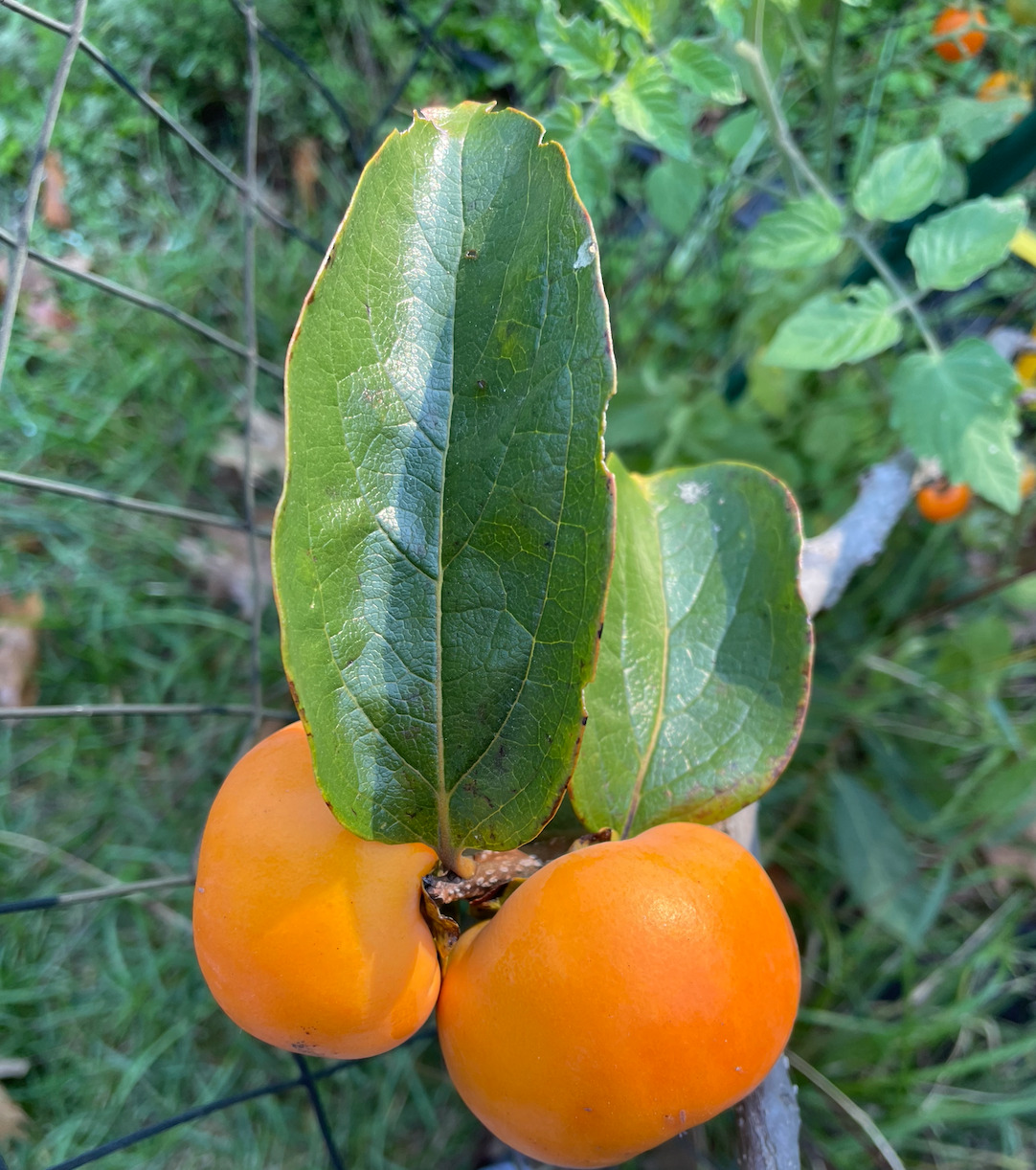Persimmons come in several different species and many different named cultivars. At the POP Learning Orchard at The Woodlands, we have six different cultivars currently growing! We planted each of these to learn more about the resilience and taste of each type and potentially to propagate new trees through grafting. Planting a polyculture also creates a safety net, of sorts. If one cultivar has a bad year for any reason, the other persimmons may still be productive.

A little About the Persimmon
The persimmon is the edible fruit of a number of species of trees in the genus Diospyros, a deciduous tree in the Ebenaceae family. A number of non-persimmon species of the genus Diospyros are grown for ebony timber.
There are several species of persimmon that are suitable for human consumption, including Diospyros kaki (japanese persimmon), Diospyros virginiana (American persimmon), Diaspyros texana (Texas persimmon), and Diospyros lotus (date plum). At the woodlands, we grow varieties of Diosporos kaki (Japanese persimmon) and hybrid trees that are crossed between the Asian and American varieties.
The Japanese Persimmon (Diospyros kaki), is an important and extensively grown fruit in China and Japan, where it is known as kaki. It is the most widely cultivated species of persimmon and is a smaller tree with larger fruit. Typically the grafted cultivars reach 4.5 to 6 metres (15 to 20 feet) in height. It is hardy from zones 7-10.
The American Persimmon (Diospyros virginiana) is a larger tree with small fruit, typically growing 6 to 18 meters (20 – 60 feet) in height. It is native from the Gulf states north to central Pennsylvania and central Illinois and hardy to zone 5. The tree grows wild but has been cultivated for its fruit and wood since prehistoric times by Indigenous people of the region and there are also some named, improved cultivars available.

Oct 2023
Plant Biology
The deciduous leaves of the persimmon are medium to dark green, broadly lanceolate, stiff and equally wide as long. Blooming from May to June, pollination requirements depend on species. Asian persimmon cultivars are typically self-fertile or in some cases, do not require pollination at all to produce fruit. American persimmon trees are typically either male or female (requiring at least one of each for pollination), but some named cultivars produce both types of flowers and are self-fertile. Furthermore, the sexual expression of American persimmons may vary from year to year. Unusually, persimmon fruits often ripen when the leaves have mostly fallen off the tree, typically in October and November. The varieties we host at the woodlands prefer full sun and are self-pollinating.
Read more about persimmons in our previous POP plant highlight:
And here’s how to make Hoshigaki, or dried persimmons:
Tree Finder
POP has an interactive map on our website that shows all the trees, shrubs, and brambles growing at the Learning Orchard. You can scroll through and find the specific pawpaw varieties if interested in learning more. All of our persimmons are in the same row intermixed with nitrogen fixing shrubs and herbaceous plants.

Varieties:
Hachiya
Most popular persimmon variety, native to Japan, Korea, China, Myanmar, and Nepal. Acorn shaped, deep orange skin. Highly astringent until fully ripe. Ripens off tree and eaten when soft. Very sweet and flavorful. Grows in zones 7-10.
Fuyu
Fuyu persimmons have been growing across Asia for thousands of years. It is the most common non-astringent cultivar. Reddish orange skin when ripe. Flat in shape. Sweet and crunchy. Keeps well for several weeks. Grows in zones 7-10.
Nikita’s Gift
Originating from the Nikita Botanic Garden in Yalta, Ukraine, this variety is a a cross between Asian Kaki persimmon and native American persimmon. 3″ wide fruits with flat top. Astringent until fully ripe when soft like a tomato. Hardy in zones 5-8.
Rosseyanka
A cold-hardy variety first grown in Russsia, the Rosseyanka is a cross between Asian Kaki persimmon and native American persimmon. Fruits are 2-3″, tree reaches 15-25′. Astringent until ripe, so wait until wrinkled and soft to eat. Hardy in zones 5-8.
Matsumoto Wase
A variety of Asian Kaki persimmon, this variety is a non-astringent type slightly larger and rounder than Fuyu. Hardy in zones 7-10.
Chocolate
Chocolate persimmons are a rare variety of the Japanese kaki persimmon. Named for their dark, chocolatey-brown flesh, these fruits are small to medium in size. The flesh ranges from firma and crisp to fleshy and soft. It is a non-astringent variety of acorn shape. 10-12ft in height, hardy in zones 7-10.
A recent article entitled “Tracking the Elusive Chocolate Persimmon” offers more information about this unique variety.
Sources:
Morton Arboretum https://mortonarb.org/plant-and-protect/trees-and-plants/persimmon/#more-information
https://www.seriouseats.com/persimmons
DISCLAIMER
The information presented on this website is for informational, reference, and educational purposes only and should not be interpreted as a substitute for diagnosis and treatment by a health care professional. Always consult a healthcare professional or medical doctor when suffering from any health ailment, disease, illness, or injury, or before attempting any traditional or folk remedies. Keep all plants away from children. As with any natural product, they can be toxic if misused.
This POP Blog was written by Program Coordinator Erika D’Andrea with help from Co-Executive Director Phil Forsyth.
SUPPORT US! If you found this entry useful, informative, or inspiring, please consider a donation of any size to help POP in planting and supporting community orchards in Philadelphia: phillyorchards.org/donate